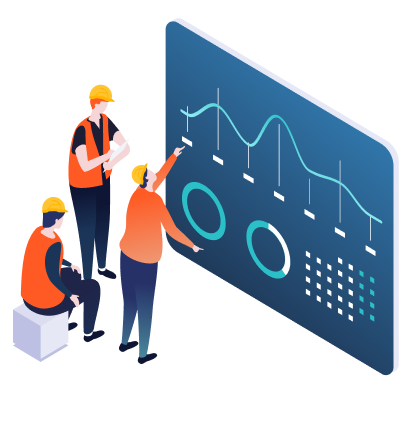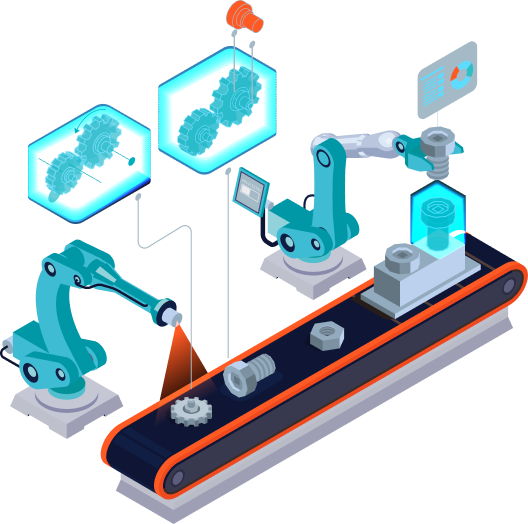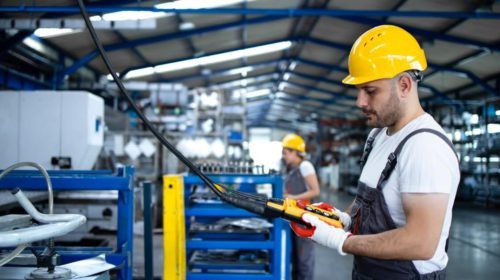
What is a Connected Factory?
Discover everything you need to know about the Connected Factory and its constituent technologies like Cloud Computing, Big Data Analytics, and IIoT.

What is a Connected Factory?
Welcome to the factory of the future, where people, processes, and data connect to unlock previously unseen levels of productivity, quality, and output. But what exactly is the connected factory?
To be frank, providing an exact definition is quite difficult. There are many definitions of the connected factory, each approaching the concept from a different angle. So instead, we’ll offer you our take.
The connected factory—also called a Smart factory—leverages a confluence of innovative technology to create a highly digitalized and automated manufacturing environment.
Put simply, it seeks to replace outdated and legacy ways of working with modern alternatives. The ultimate goal is to eliminate repetitive, non-value-adding work, whether on the frontline or administrative back-end, and to gain real-time insights into processes, equipment, and inventory in order to optimize production, reduce downtime, improve quality control, and enhance resource utilization.
Still sound abstract? Don’t worry. In the following paragraphs, we’ll run you through some of the key technologies that underpin the connected factory.
Key technologies that make up the connected factory
Industrial Internet of Things (IIoT)
Much like the Connected Factory, you’ve probably heard the term “IoT” used frequently. However, when it comes to the factory of the future, the importance of IoT cannot be stressed enough.
So, what is IoT? In essence, the term refers to the placement of sensors and other devices in machines and equipment to collect data. This data is used to communicate and alert factory workers about the status of a machine. For instance, an IoT device can keep track of an oven’s temperature. If that temperature exceeds or goes below a certain threshold, the IoT device can alert humans to inspect it, thereby preventing product quality from being impacted.
Moreover, IoT can enable machines to communicate with each other, a process known as Machine-to-Machine (M2M) communication. This allows them to exchange production data and synchronize their operations.
Another important feature of IoT is that it allows manufacturers to predict when a machine needs maintenance. This is key in reducing unplanned downtime, which can lead to signifcant disruptions to production.
Advantages
- Automatic alerts to frontline personnel
- Granular data on machine performance and operations
- Prevention of downtime, breakdowns, quality issues, etc.
- Automatic synchronization of machine operations
Cloud Computing
Cloud computing plays a big role in the connected factory because of its unparalleled storage, processing, and analytical capabilties. It is at the core of things such as advanced analytics, machine learning, and predictive analytics.
Additionally, the cloud enhances data security and the availability of manufacturing IT systems. This prevents on-premise outages from disrupting operations. Moreover, the accessibility of cloud computing systems enables all factory stakeholders to access data and applications, even remotely, thereby enhancing a factory’s collaborative capabilities.
Advantages
- Enhanced security
- Unparalleled computational power
- Increased collaboration

Big Data Analytics
Big Data Analytics leverages the enormous wealth of data that IIoT sensors gather to extract valuable insights and detect patterns. By combining this technology with machine learning, manufacturers can predict when a machine needs maintenance, for example, thereby avoiding costly amounts of downtime and increasing the lifespan of equipment.
Another example comes in the area of energy consumption. By gathering and analyzing the data of energy-related equipment, manufacturers can pinpoint the areas where energy consumption could be optimized. Apart from having an impact on costs, Big Data Analytics can therefore open up a doorway to more sustainable manufacturing.
Advantages
- Improved quality, maintenance, inventory management, etc.
- Enhanced insight into operations
- Prediction of anomalies, breakdowns, etc.
Robotics and automation
Robots are already widely used in manufacturing to automate repetitive, non-value-adding work. In the future, manufacturers will leverage the use of so-called Co-bots to work in collaboration with human personnel.
The use of robots and automation frees up humans from repetitive or dangerous work, such as the handling of hazardous materials. Furthermore, robots are used to perform tasks such as soldering, welding, and fastening with improved accuracy and speed. Various organizations, such as Tesla, already leverage this technology on a large scale.
Advantages
- Automation of non-value-adding work
- Increased quality of end-products due to enhanced accuracy
- Increased data analysis capability due robots collecting data

The role of Connected Worker Platforms in the connected factory
The Connected Worker Platform is a crucial technology for the connected factory. In short, it is a one-stop-shop, mobile-enabled platform that digitalizes the majority of an operator’s daily tasks.
Why is it so important? Well, Connected Worker Platforms are key in connecting many of the technologies we outlined above with the operators on the shop floor.
A common issue with IoT, for example, is that its data is often displayed on large screens that frontline personnel cannot read. A Connected Worker Platform connects IoT triggers with the handheld devices used by frontline workers. When the IoT network discovers an anomaly, operators are alerted instantly, which has a big impact on MTTR.
In summary, the Connected Worker Platform is the ultimate connecting factor, leveraging the potential of the above technology and placing it in the hands of human personnel. Our CRO, Elmer, explored the Connected Worker Platform’s role in more detail at last year’s Hannover Messe. You can watch his talk here on YouTube.
Related Articles

A complete guide to the Connected Worker


